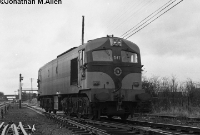Thurles Junction
Thurles Junction, north Co.Tipperary, on the main Dublin to Cork line is located just south of Thurles town. The junction was established here when the independent Southern of Ireland Railway, latterly taken over by the Waterford & Limerick Railway, who later became part of the Great Southern & Western in 1901, extended their line north from Clonmel to Thurles in 1880. There was no station at the junction, passengers having to change trains conveniently at Thurles Station. The junction was controlled by an adjacent signal cabin on the up side of the line. In the 1920s, a sugar beet factory was established just south of Thurles town, and sidings were built on the down side of the main line on the approach to the junction, as well as a spur which entered the beet factory compound.
Passenger services between Clonmel and Thurles ceased in 1963, but the line remained in use for goods until 1967. A stub of the former line was however retained as a siding until the early 1970s, leaving the signal cabin to control just the adjacent sugar beet sidings. However, Thurles beet factory ceased operation in 1989, with trains diverted to the Mallow plant in Co.Cork. The beet sidings, as well as the spur into the factory, which featured a level crossing over the Holycross road, were removed along with the signal cabin.
The remains of Thurles Junction can still be seen today, the site of the beet sidings however have been replanted with trees. The spur between the sidings and factory is now occupied by a new housing estate, but the old level crossing, as well as several pieces of track still exist within the former sugar beet factory, now used by several different industries.
Passenger services between Clonmel and Thurles ceased in 1963, but the line remained in use for goods until 1967. A stub of the former line was however retained as a siding until the early 1970s, leaving the signal cabin to control just the adjacent sugar beet sidings. However, Thurles beet factory ceased operation in 1989, with trains diverted to the Mallow plant in Co.Cork. The beet sidings, as well as the spur into the factory, which featured a level crossing over the Holycross road, were removed along with the signal cabin.
The remains of Thurles Junction can still be seen today, the site of the beet sidings however have been replanted with trees. The spur between the sidings and factory is now occupied by a new housing estate, but the old level crossing, as well as several pieces of track still exist within the former sugar beet factory, now used by several different industries.





















